Deutsche Guernsey Zeitung
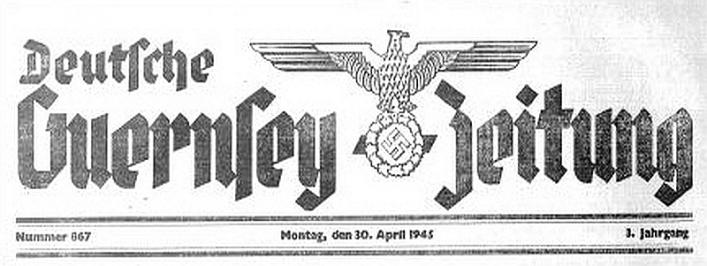
Deutsche Guernsey Zeitung, The Guernsey Press, Guernsey, 1942-45; Deutsches Leben, Guernsey, 1943; and other materials produced by or for the occupying forces, 1940-45. [By Dinah Bott]
Deutsche Guernsey Zeitung (DGZ) was a daily newssheet for the German occupying forces, published by the Guernsey Press. Although Jersey had already had a forces newspaper published in the same way since 1940, known as Deutsche Inselzeitung, the DGZ was not launched until 4 July 1942; it was produced daily until 24 March 1945, when publication was reduced to every two days. (The English-language Guernsey Press, which was a shadow of its former self and inevitably a mouthpiece for the German version of events, was not printed on Tuesdays or Thursdays. The gaps were filled by the Star, publication of which was only on Tuesdays and Thursdays, and which was suspended from September 12 1944 until January 10, 1945, as a result of 'the imperative need to economise in gas and electricity.') Sonderführer (Z) Herbert Ladda was editor of DGZ until 24 July 1944, after which the office was taken over by Oberleutnant Schmidt-Walkhoff. The Press found itself without special characters for the German language, and had to spell them out in full as best it could.
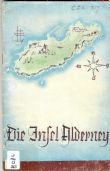
The newspaper usually consisted of one sheet, but occasionally specials were produced with two. The supplementary pages of these special editions tended to contain stories and jokes, or articles of general interest. In 1944 a brochure was published by DGZ to 'facilitate acclimatisation' for troops in Alderney.1
The newssheet featured news from the various battlefronts and messages from German commanders, as well as political, social, and sports news from Germany, especially league football results. Entertainment was provided by puzzles, jokes, and cartoons. Later editions began a serialisation of Victor Hugo’s Toilers of the Sea, translated into German, which was eventually published as a book for those soldiers who were interested. (There is a copy of Part One of Des Arbeiter des Meeres in the Library collection.) Every day saw an Insel Chronik, with news and information specifically for the island. Troops were exhorted to make use of the facilities in the Soldatenheim, especially the Library. There was a great deal of music-making, with practices and concerts almost every day, the recitals taking place in the Soldatenheim or Candie Gardens. The band master advertised instruments available to borrow, including a cello and an accordion; they ran a 'where are they now?' section, where soldiers wrote in to inquire if any one else knew the whereabouts of colleagues on other fronts; several dogs were lost by the Germans, including a hunting-dog and a golden spaniel called Tommy, as well as coats and wallets.
The troops were reminded which of the beaches and Bathing Pools were open to civilians and which to them. They held running races around St Peter Port, and innumerable football and handball matches took place between teams of soldiers. One of the strangest events to occur to local eyes now was the competition for what is now known, for want of a proper title, as 'the Occupation Cup'. In an ersatz mirroring of the Channel Island Derby matches, or Muratti Cup, which began in 1905 between Guernsey, Jersey, and Alderney and which was suspended during the war, a team of German soldiers representing Guernsey played against a team of German soldiers representing Jersey. The DGZ of 4 May, 1944, reported the match 'Jersey's Eleven put their hearts into it'. In front of what was claimed to be a record crowd of 4,000, the 'Jersey' team apparently played football so good it would have shamed the German national team, and beat 'Guernsey' by five goals to four.
.jpg)
The DGZ reported events from the front which could not always be glossed over. June-August 1944 saw the Normandy Invasion, with action only a few miles away. On 30 June, the death of Generaloberst Friedrich Dollmann was recorded, with a photograph (see picture). Dollmann commanded the 7th Army during the invasion of France and remained there overseeing the defence of Normandy and Brittany. The most complete and impressive gun battery to be seen in Guernsey today, now restored, the Battery Dollmann at Pleinmont, was named after him. He died of a heart attack after learning he was to be court-martialled following the fall of Cherbourg. On the 4 July, the headline of the DGZ was Die Invasion aus der Inselperspektive; on the 5th, Flakfeuer schirmt den Hafen; on the 27th, the Alderney batteries were reported as having been fired. Beginning on 14 July, however, the DGZ also began a series on Tomaten—aber wie?, inviting recipes to make the best use of Guernsey’s most famous crop. Recipes for tomatoes and gherkins were duly sent in, presumably by the soldiers, who provided enough to print on several consecutive days. On 26 August they started up a stamp-collecting club.
On 30 April 1945, DGZ printed a message from Hitler addressed to the Festungkommandanten of the Channel Islands, amongst others. Vizeadmiral Friedrich Hüffmeier signalled back: 'On behalf of my officers and men I thank the Führer for his remembrance even at this hour. We shall be as faithful to him as he always is to us. Our way is clear. Only our Führer’s Germany. Heil to our beloved Fuhrer.'2
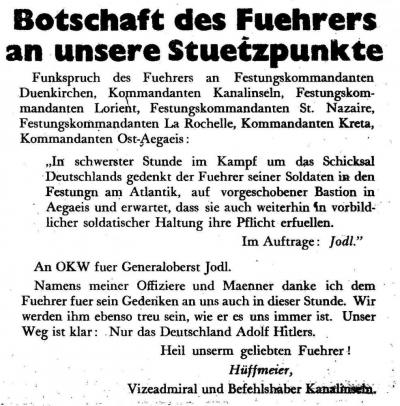
The last edition of DGZ, on 8 May 1945, begins with a list of Allied advances and positions in Europe, with no comment.
DGZ was published entirely in German and was intended to be read by the occupying troops. Although there was no attempt made by the Germans to politicize education as a whole, Hitler had become determined early on in the war that Channel Islanders should have knowledge of German and issued an edict to that effect.
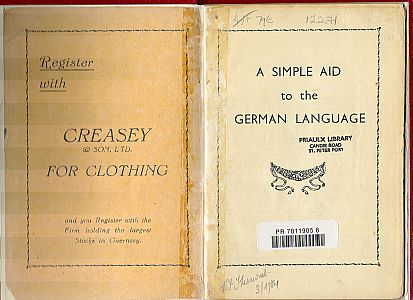
The authorities resisted instituting compulsory German classes for schoolchildren, as they already had lessons in both English and French. There were very few teachers with any knowledge of German, but when the German authorities threatened to use German officers instead, the island teachers agreed to take German lessons themselves (with varying degrees of success).
Early in 1941 the Feldkommandatur asked how many children wanted to volunteer to study German ... this was not enough ... and the question of compulsory German was broached by the Feldkommandatur in 1942.Their memorandum ... begins by noting that relatively few children remained in the Islands [1,100 schoolchildren remained on Guernsey], and that standards had fallen 'since the intelligent ones went to England.' ... French instruction should not be cut out. A strengthening of the Norman and Breton elements as a basic movement was desirable. Further there were historical grounds for retaining French.
It was nevertheless considered possible to introduce German ... Ideally there would be compulsory German for all pupils over 10 but it would be difficult to find teachers outside the main centres, so the country schools would have to be excluded from any scheme.The memorandum concluded: 'Opposition to the German language naturally exists in large measure. People do not want to learn the language of the enemy'.3
Following procrastination and poor turnout to voluntary classes, Jersey authorities reluctantly agreed to compulsory classes for all children over 12 years of age for three quarters of an hour, four times a week. In 1943, Sonderführer Bleul issued an order to the Guernsey Education Council that compulsory German lessons were to be introduced in all schools, much to the Council’s distress. French instruction was continued, but in order to accommodate the five 45-minute periods of German a week, English lessons were curtailed. The German authorities chose a popular textbook of English origin, Deutsches Leben, (which continued to be used in some island schools after the war). Its author, A.S. Macpherson, a Dulwich College schoolmaster, must have been unaware that in September, 1941, in what was in effect a German-inspired pirate printing operation, copies of his book were being produced in Guernsey on cheap paper.4
The President of Guernsey’s Education Committee, Jonathan Roussel, wrote the Foreword.
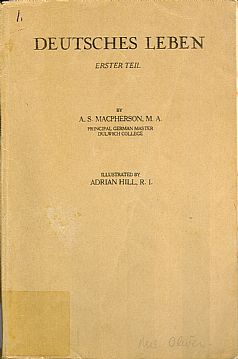
On 5th January 1943 the States of Jersey Public Instruction Committee wrote to the German authorities requesting them to ask the Guernsey authorities to supply 1600 copies for use in Jersey schools.5 They also ordered copies from Germany of Juncker's German-English Dictionary, which proved difficult to come by. The German authorities gave out annual prizes to the best students and teachers; books that were bought with money raised at the German’s many military band concerts.

The Germans provided the local populace with their own version of the US LIFE magazine. At its height, over 2,500,00 copies of Signal were produced in over forty languages and distributed throughout occupied Europe, with two editions a month.The Library has a complete run* of rare English-language editions, published in Paris specifically for the Channel Islands from 1943 until the fall of Paris in May 1944. Although Paris Match is said to have modelled its design on that of Signal, and some of Germany's best photographers and writers worked on it, it tended to be ridiculed by wartime Guernsey diarists, for whom it was nothing but blatant propaganda.
When the Channel Islands were first occupied, the British were able to drop leaflets for the benefit of the local populace in an effort to keep up morale. In the end, only two editions ever made it to the islands.
On Tuesday we hear the story.Machine guns were heard from 2 till 3 a.m., probably the leaflets were dropped then. I was shown one of the leaflets, messages to us, and a picture of the King and Queen looking at the damage done by a bomb to Buckingham Palace. There were hundreds scattered all over the greenhouse area from Saint’s Bay to Vazon where the men work. ... Everyone in town this morning was so cheerful and beaming after the dropping of the leaflets on Monday night. It was a tonic. I, for one, had been feeling at the end of my tether, everything is now quite different.
Thursday September 26 to October 1st. The smiling faces have changed. The notice about the leaflets has appeared. If you have found one it must be handed in at once to the Feldkommandatur at Grange Lodge. The penalty for having one or reading one or showing it to anyone is fifteen years’ penal servitude.6
You can read the first of the two leaflets, dropped on the same day in September 1940, here.
The allies, however, were more successful elsewhere.
German-born to an Australian father, educated in England, Sefton Delmer was a journalist, who, while working for the Daily Express in Berlin, became the first British journalist to interview Hitler. His friendship with Ernst Röhm and Hitler in 1932 led to his being suspected of Nazi sympathies, though the Nazis were convinced he was working for British intelligence.In fact, he became an integral part of the black propaganda campaign waged by the British and Americans against the Germans, which was to prove so effective in misleading them as to the Allies’ plans during the invasion of Normandy. He broadcast to the German troops as part of the PoliticalWarfare Executive (PWE), transmitting the radio station Soldatensender to Calais from Crowborough; the Germans were so convinced of its authenticity they used it to plan their movements when their own communications broke down, enabling the PWE to mislead and entrap them. Delmer also oversaw the production of a daily 'grey propaganda' German-language newspaper, Nachrichten für die Truppe.
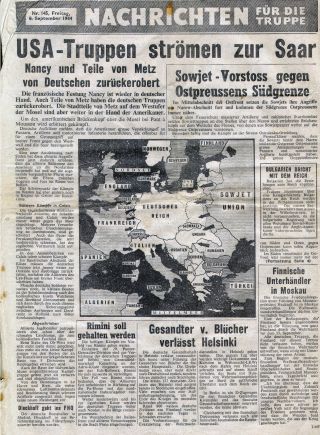
Nachrichten was disseminated over the German frontlines each morning by the Special Leaflet Squadron of the US 8th Air Force. Much of its text was based on the Soldatensender broadcasts. In the autumn of 1944, the PWE arranged for thousands of copies of Nachrichten to be dropped over the Channel Islands over 12 consecutive nights, as part of an operation intended to soften up the occupying forces in the hope that their commander, Lieutenant-General von Schmettow, would agree to surrender. 218 leaflet bombs were dropped in total, in the porportion three to Guernsey, two Jersey, and one Alderney, roughly relative to the estimated sizes of the garrisons. The first raid took place on the night of 30/31 August 1944, over Fort Richmond in Guernsey, St Ouen’s Manor in Jersey, and St Anne’s in Alderney. The Priaulx Library has several editions of Nachrichten, which were picked up by not only troops but also by residents, who kept them as souvenirs. Despite these efforts and the help of a captured German general who tried to influence him, von Schmettow had too much of a sense of honour to be turned and held on until the end.7 To read this copy of Nachrichten, dropped on or around 23 September 1944, click here.
All this material is available to view in the Library on request.
For examples of islanders' stories and recollections of wartime propaganda, see People's War archive.
1 Sanders, Paul, British Channel Islands Under German Occupation : 1940-1945, Jersey : Société Jersiaise and Jersey Heritage Trust, 2005, p. 205
2 Tabb, Peter, A Peculiar Occupation: new perspectives on Hitler's Channel Islands, Hersham, Ian Allan, 2005, p. 188
3 Cruickshank, C., The German Occupation of the Channel Islands, London, for the Trustees of the Imperial War Museum, Oxford University Press, 1975, p. 146
4 & 5 Jenny Chamier Grove, Channel Islands Occupation Review 31, p. 56 'Compulsory German Classes'
6 Harvey, Winifred, ed. Booth, Rosemary, The Battle of Newlands, Guernsey Press Co. Ltd,, Guernsey, p. 33.
7 Cruickshank, C., The German Occupation of the Channel Islands, p. 253 (* except No. 23 of 1943)
see also: LIFE, 14 (12), March 22, 1943, U.S. is Losing the War of Words; Mayer, S. L., ed., Hitler's wartime picture magazine 'Signal', London: Feltham: Bison Books; distributed by Hamlyn, 1976
Mayer, S. L., ed., Signal: Years of retreat, 1943-44, Hitler's wartime picture magazine, Englewood Cliffs, N.J: Prentice-Hall, 1979
